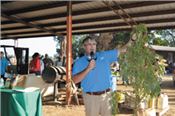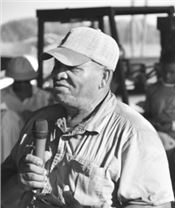|
North La. Farm Tour Provides Updates On Crop Research
BASTROP, LA.
Despite sweltering temperatures, nearly 200 participants attended the annual Black Farmers Field Day in Collinston.
The field day has been held for the past 14 years as a way of letting young people see what’s involved in the production of food, fiber and shelter. Another goal of the event is to show off some of the latest research findings from the LSU AgCenter and Southern University Ag Center.
Southern University extension agent Odis Hill, coordinator of the field day, sees the event as a way to develop an interest in agriculture.
“It’s important to let the public know that we still have a few African-Americans involved in row crop agriculture, and we’re trying to encourage the youth to become involved in the industry,” Hill said.
“The Morehouse Black Farmers and Landowners Association started about 20 years ago to help us to pool our resources and to gain information for the public,” Hill said.
Each year, the field day kicks off at the farm of Harper Armstrong, who farms more than 2,000 acres of corn and soybeans.
“We do this field day because we want to look toward the future,” Armstrong said. “We want to show the young people that technology has made farming a lot easier than it was for my daddy and granddaddy.”
LSU AgCenter weed scientist Daniel Stephenson discussed the problems growers are having with the control of ryegrass and pigweed.
“It is imperative that our growers use a residual herbicide, whether that be immediately behind the planter or in the first post-application,” Stephenson said. “There are 15 to 20 pre-emergence herbicides that can be used.”
AgCenter cotton and corn specialist Dan Fromme has a positive outlook for this year’s crop, even though there are some mixed expectations in various parts of the state.
“Some growers say this is possibly the best corn yields they’ve had in several years, and that’s saying something when you look back at 2014 and 2015,” Fromme said.
The central part of the state seems to have the best potential because growers didn’t have the amount of flooding that plagued the northern parishes, he said.
“The northern area was hit hard by flooding, so there’s a mixed bag this year,” Fromme said. “Southern rust is a major disease we’re encountering this year because of the wet weather we’ve had.”
Fromme is expecting exceptional yields of grain sorghum, and he’s expecting harvest to begin for corn and sorghum this week.
Floods in north Louisiana have caused mixed results in cotton yields because of the differences in planting dates, from early April in the central parishes to late May to early June in the northern areas, he said.
LSU AgCenter soybean specialist Ronnie Levy said for this time of the year, he’s seeing some really good crops.
“We’re hoping for prices to rise because we have about 1.25 million acres planted, which is a little lower than last year due to the large corn acreage that was anticipated,” Levy said.
AgCenter agritourism coordinator Dora Ann Hatch, along with Mississippi State University senior wildlife associate T. Adam Tullos, discussed some of the potential revenue generators for private landowners. Hatch works with landowners to develop agritourism on their property as a second income.
Dewayne Goldman, director of stakeholder relations for Monsanto, gave information on the National Black Growers Council (NBGC) and its relationship with the Morehouse Black Farmers and Landowners Association.
“The National Black Growers Council was established in 2008 as an advisory group for Monsanto,” Goldmon said. “About halfway through the first meeting, we decided this was too big for one company.”
From there, the group joined the Louisiana group in sponsoring the annual tour, which each year includes farms in Mississippi, Arkansas, Louisiana, Florida and Alabama.
Other features of the event included a workshop on irrigation, a youth field demonstration and an update on the National Black Growers Council, along with speakers from agencies of the U.S. Department of Agriculture and a sponsored lunch. ∆

LSU AgCenter weed scientist Daniel Stephenson discusses problems growers are having
with the control of ryegrass and pigweed at the Morehouse Parish Black Farmers Field Day in Collinston.
Photo by Tammi Arender

Morehouse Parish farmer Harper Armstrong welcomes attendees to the annual
Black Farmers Field Day held on his farm near Collinston.
Photo by Johnny Morgan
|
|